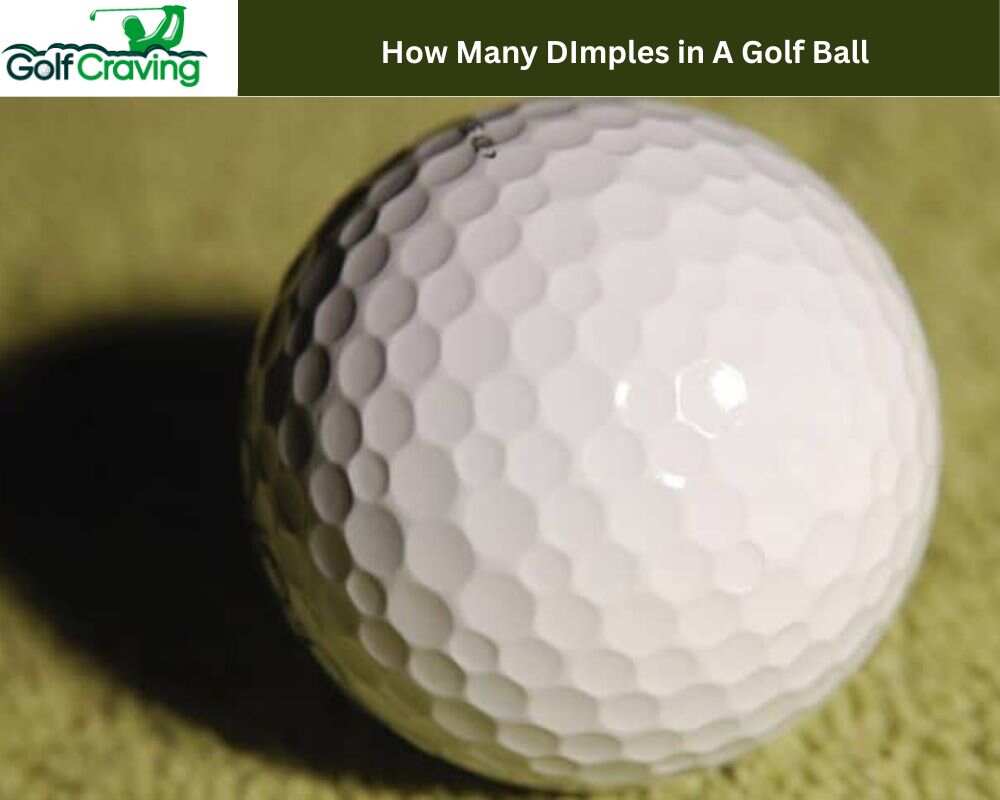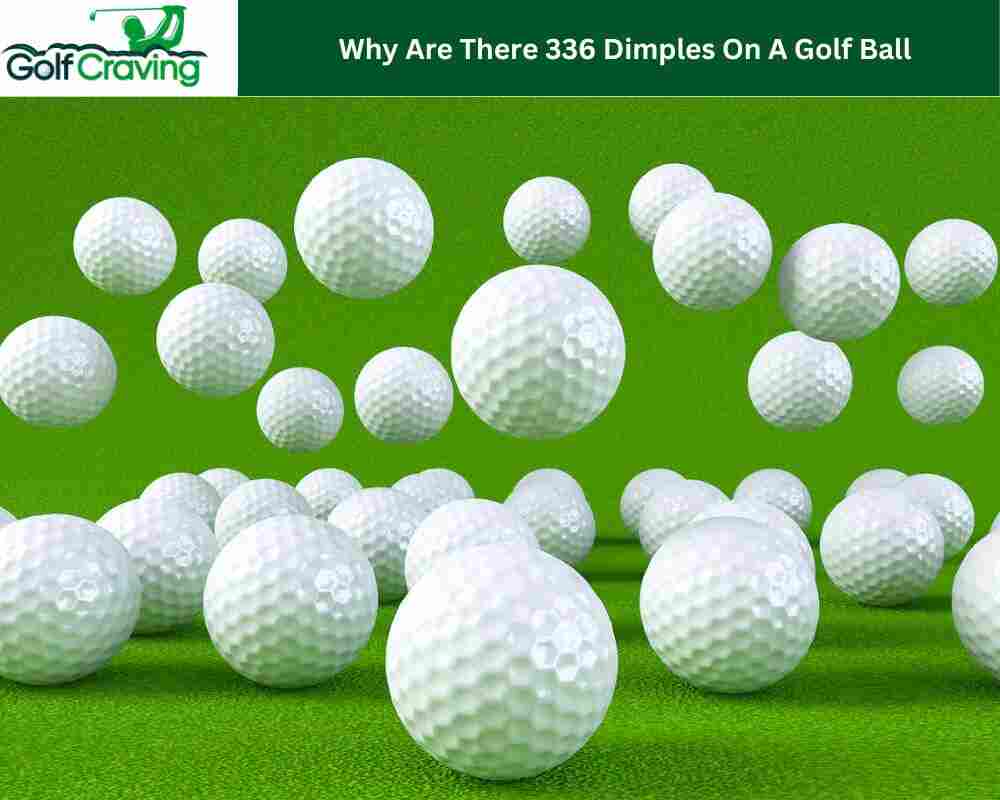The dimples on your golf ball may intrigue you. The interesting fact is that the dimples are not only for aesthetic purposes. They play a big role in determining your performance.
Various configurations of dimples have been tested and tried throughout the years, with 336 being among the most prevalent in contemporary golf balls.
So, why are there 336 dimples on a golf ball? The 336 dimples help your golf ball to optimize lift while also minimizing aerodynamic drag. Thus, you can cover more distance with accuracy when hit. Also, it gives better control to the balls.
That’s not all we found! Let’s get into more detail about the purpose of 336 dimples in your golf ball.
How Many Dimples in A Golf Ball?

The aerodynamic performance of a golf ball is optimized using its typical 336 dimples distributed over its surface. The arrangement of these dimples is technically decided to lessen the ball’s resistance to air resistance.
Some golf balls have less than 300 dimples, while others have more than 400. The exact arrangement and amount of dimples can also differ from one model to another.
The dimples boost lift and reduce drag by chopping off the airflow surrounding the ball, forming a boundary layer of turbulent air. Because of this aerodynamic phenomenon, the golf ball can go farther and stay in the air longer, which improves the player’s game.
The golf ball’s design and intended function determine the form and size of these dimples. The ball’s flight properties can be optimized with dimples of various shapes, including circular, elliptical, or teardrop-shaped.
For example, golf balls that are intended for aerodynamics usually have shallower dimples, which help with distance off the tee and control and accuracy on the green. On the other hand, distance balls can have deeper or bigger dimples.
Why Are There 336 Dimples On A Golf Ball?

The reasons behind the 336 dimples on your golf ball are rather practical than to increase the aesthetics.
Reducing Drag
Golf balls have dimples to minimize drag. Drag means the force that opposes the ball’s motion through the air. Dimples create a turbulent boundary layer of air around the ball, delaying airflow separation and reducing the size of the wake behind it. As a result, it increases the speed and moves your ball further.
Increasing Lift Through Pressure Difference
Dimples also enhance lift by generating a pressure difference between the top and bottom of the ball. As the ball spins, the Magnus effect causes air to move faster over the top surface and slower underneath. Thus, it helps create a pressure differential that pushes the ball upwards. This increased lift contributes to higher trajectories and longer carry distances.
Optimizing For Reynolds Numbers
Golf ball dimples are designed to function within specific Reynolds numbers, typically ranging from 4 x 10⁴ to 4 x 10⁵. At these Reynolds numbers, induced turbulence from the dimples reduces drag and enhances lift.
Transitioning From Laminar To Turbulent Flow
Dimples induce turbulence in the airflow around the golf ball, particularly in the transition region between laminar and turbulent flow. In this range, small perturbations easily disrupt the flow. By strategically creating disturbances with dimples, golf balls induce turbulent flow at lower Reynolds numbers, further minimizing drag and maximizing lift.
When Did Golf Balls Get Dimples?
During the period of guttie golf balls, which emerged accidentally in the mid-1800s, the first golf balls with dimples appeared. Robert Adams Paterson’s early balls, made from molded tree sap, were fragile and easily dented.
Golfers were surprised to see that imperfect gutties flew the ball more consistently than perfect ones. Ball manufacturers saw this trend and started playing around with purposeful surface modifications.
An innovator made a groundbreaking discovery in the early 20th century when he found that indentations, not higher protrusions, greatly enhanced the performance of balls. The following year, 1905, an English manufacturer named William Taylor invented a golf ball design with dimples.
The development of dimple-covered golf balls, which are commonplace now, began with this invention. Golf balls with modern dimple patterns have been painstakingly designed and tested using high-tech equipment to maximize distance and control.
Different Dimple Patterns You Should Know
A golf ball’s aerodynamic performance is heavily dependent on the design and pattern of its dimples. Spherical ones are the most prevalent patterns that you will notice. In a traditional dimple pattern, the dimples are not all the same depth; rather, they are spread out around the ball in a strategic arrangement.
On the other hand, hexagonal dimple patterns offered by brands like Callaway promise to improve performance by decreasing drag and increasing lift. Efforts to improve golf ball performance through aerodynamics have been continuous, and these dimple design changes reflect that.
What Is The Ideal Dimple Range On A Golf Ball?
Several variables, including dimple depth, edge angles, and form, must be considered to establish the optimal dimple range on a golf ball. The flight and general performance of the ball are greatly affected by these features.
Golf balls that don’t have enough dimples are overly smooth, which might cause them to fly erratically and slow them down. The air pressure dynamics of a ball can be affected when there are too many dimples, which slows it down and makes it spin less effectively.
Usually, a dimple count between 220 and 430 is considered excellent for performance. For many golfers, this range represents the sweet spot between reliability and efficiency. Golf balls fly steadily, reach the desired speeds, and show consistent spin characteristics within this range.
Frequently Asked Questions (FAQs)
How many dimples does an average golf ball have?
The typical number of dimples found on a golf ball ranges from 250 to 500, with 336 being the average. To maintain uniform function, these dimples should be symmetrical.
How many dimples does a Pro V1x have?
Compared to its counterpart, the Pro V1, Titleist’s Pro V1x golf ball has 348 dimples. There are 322 dimples on the TaylorMade TP5, and 332 on the Carver Golf Ball, two other well-known balls.
Why do dimples reduce drag?
Golf balls have dimples that make the boundary layer flow surrounding the ball more turbulent, which reduces drag. Because the boundary layer’s separation point is decreased due to this turbulence, the ball can travel farther and more efficiently through the air with less drag.
Conclusion
The reasons behind why are there 336 dimples on a golf ball are quite interesting, don’t you think so? Well, now that you know the functional purposes of the dimples, choose a golf ball that can give you the best benefits.
Overall, how many dimples you need will depend on your taste and type.
